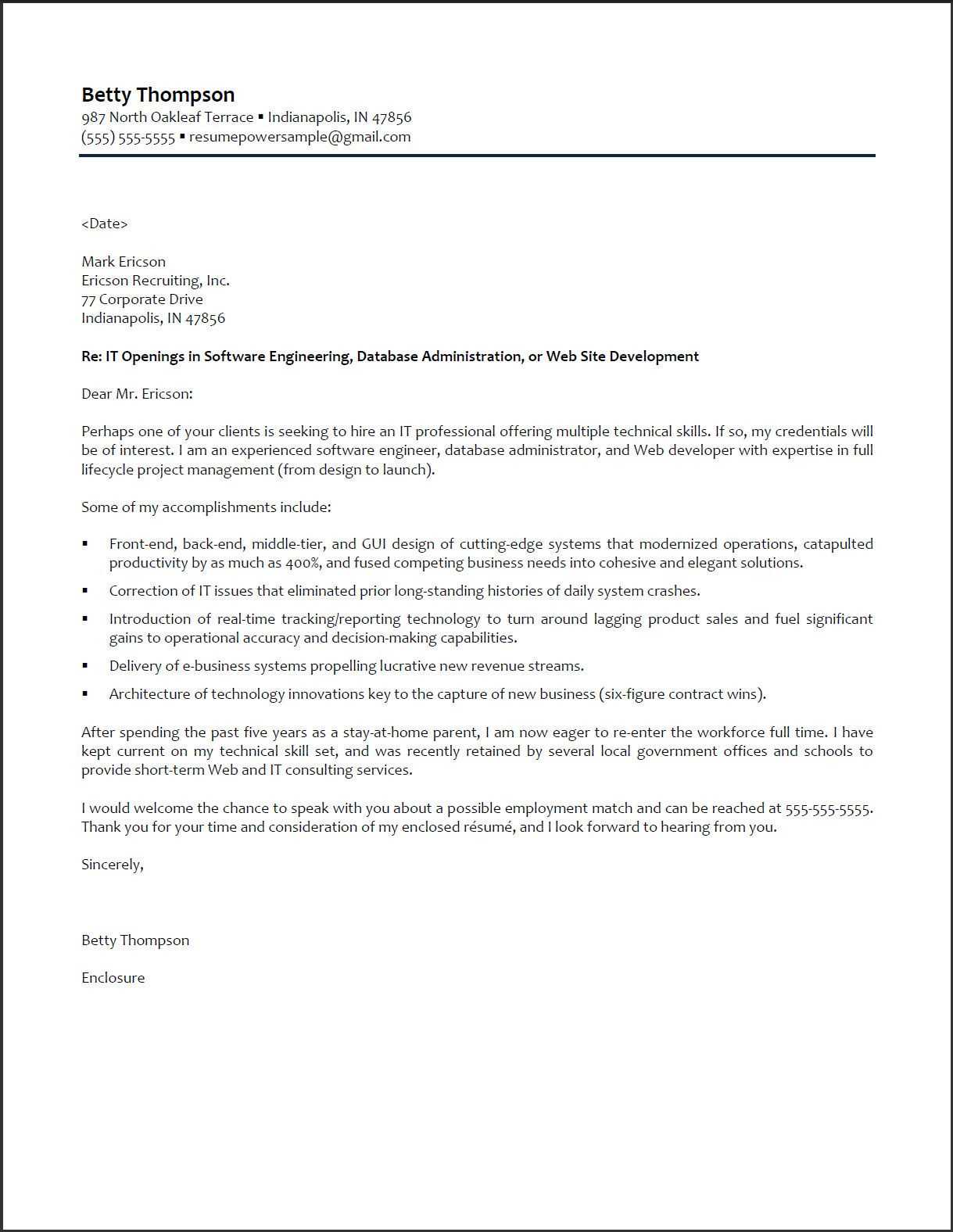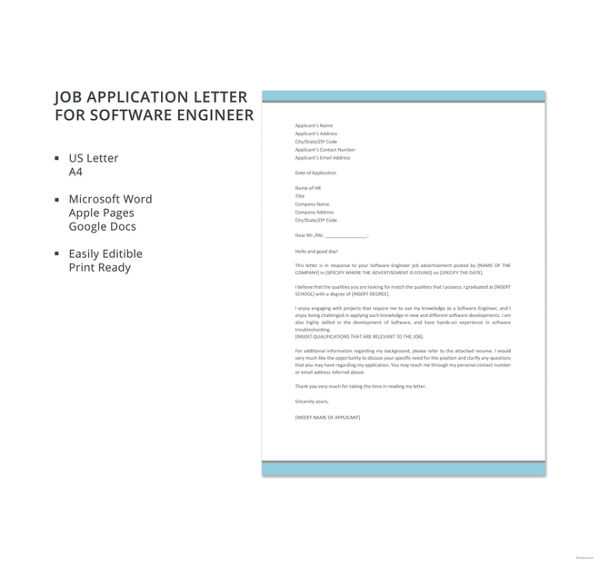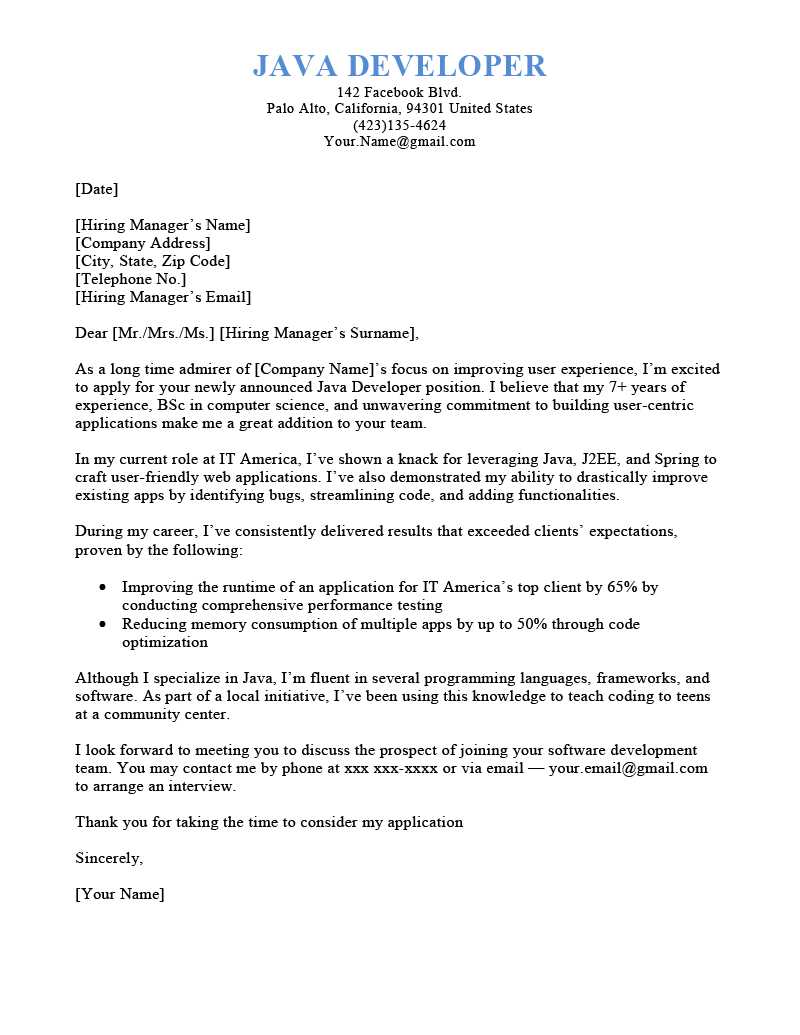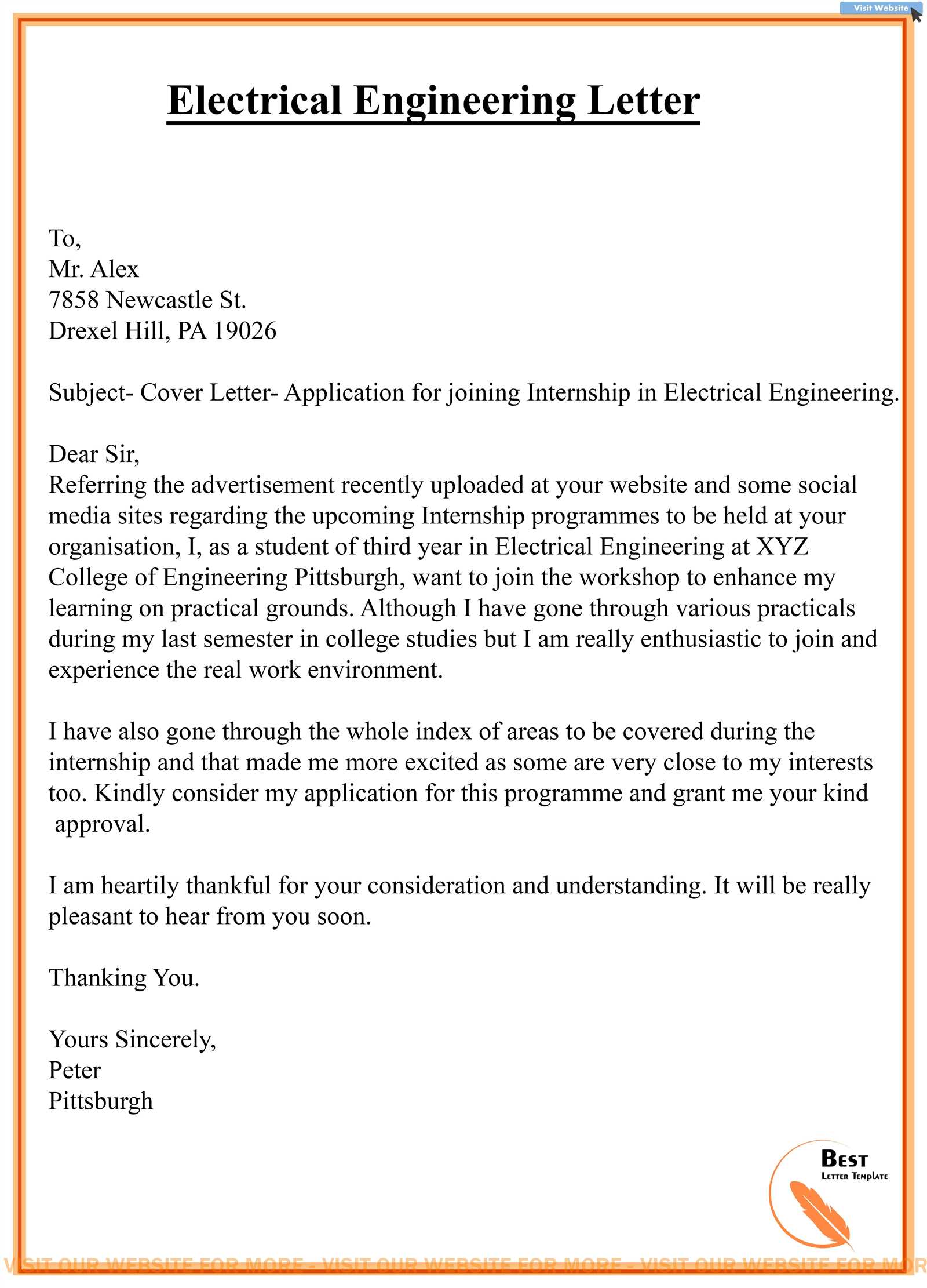Cover letter software engineer template

Use a clear and concise template when crafting your cover letter as a software engineer. Begin by directly addressing the job title and company you’re applying to, highlighting your relevant experience and skills. Tailor each section to reflect the job requirements and demonstrate how you align with the company’s values and goals.
Introduction: Open with a brief statement of interest. Mention how your technical skills and experience in software engineering make you an ideal candidate for the position. Don’t hesitate to mention any specific projects or achievements that directly relate to the job.
Body: In the body of the letter, emphasize your hands-on experience with programming languages, development tools, or frameworks that are essential for the role. Focus on practical applications of your skills, and show how your previous work translates into value for the employer. Highlight any collaborations or leadership roles, as teamwork is often a key part of software engineering projects.
Closing: Conclude with a confident statement expressing your enthusiasm about the opportunity. Thank the employer for considering your application, and mention that you look forward to discussing your qualifications further in an interview. Keep the tone polite and professional, avoiding over-explanation.
Cover Letter Software Engineer Template
Crafting a compelling cover letter as a software engineer requires focusing on the key skills and experiences that align with the job description. Start by addressing the hiring manager directly, using their name if possible. Tailor the introduction to reflect your enthusiasm for the specific role and company.
Key Sections to Include
- Introduction: State the position you are applying for and how you found out about the opportunity. Briefly mention your current role and expertise.
- Relevant Experience: Highlight your key achievements and skills, emphasizing specific projects that demonstrate your problem-solving abilities, coding proficiency, and collaboration with teams.
- Why This Role: Explain why you are interested in this particular position and how your skills align with the company’s goals. Show that you’ve researched the company and understand its values.
- Closing Statement: Reaffirm your enthusiasm for the position and your willingness to discuss how you can contribute to the team. Thank the reader for considering your application.
Example Template

Dear [Hiring Manager’s Name],
I am excited to apply for the Software Engineer position at [Company Name], which I discovered through [Job Board/Company Website]. With a strong background in software development and a passion for [specific technology or field], I am confident that I can contribute effectively to your team.
In my current role at [Current Company], I have led projects that involve [specific technologies, e.g., JavaScript, Python, cloud computing], achieving [mention a specific outcome or improvement]. One of my key accomplishments was [describe a project or achievement]. This experience has honed my skills in [relevant skills], making me well-equipped to tackle the challenges of the [Job Title] role at [Company Name].
I am particularly drawn to this opportunity at [Company Name] because of your commitment to [mention a company value or initiative]. I am excited about the prospect of contributing to [specific project or goal] and working alongside your team to achieve [company’s objective].
Thank you for considering my application. I look forward to the opportunity to discuss how my experience and skills can benefit [Company Name].
Sincerely,
[Your Name]
How to Structure Your Cover Letter
Begin with a concise introduction. Mention the position you’re applying for and briefly explain why you are interested in the role. Be direct and relevant–avoid lengthy explanations. Tailor the opening to reflect your enthusiasm for the company and role specifically.
Highlight Your Skills and Experience
In the body, focus on your qualifications. Choose a few key skills or experiences that align directly with the job description. For each one, explain how it prepares you for the position, showcasing concrete examples of your achievements. Avoid generic statements; be specific about your contributions and results.
Conclude with a Strong Call to Action
End with a clear and confident closing. Express your eagerness to discuss how you can contribute to the company. Invite the reader to contact you for an interview and restate your appreciation for their time. Keep the tone positive and professional. Make sure the closing leaves a lasting impression, showing your commitment to the opportunity.
Personalization Tips for Maximum Impact

Tailor your cover letter to the specific company and position you’re applying for. Avoid generic statements and show genuine interest in the role by referencing details from the job description.
- Address the hiring manager by name. If the name isn’t provided, research the company website or LinkedIn to find the right person.
- Use the company’s language. Highlight keywords or values from the job listing and incorporate them naturally into your cover letter.
- Demonstrate knowledge of the company. Mention recent projects, news, or products that align with your skills or experience.
- Share how your experience connects with the job requirements. Give specific examples of how your past work aligns with what they’re looking for.
- Express enthusiasm for the role. Let your passion for the job and the company shine through, but keep it sincere.
Personalizing each cover letter increases your chances of standing out and shows that you’ve invested time in understanding the company and position.
Key Skills to Highlight for Software Engineers
Start with proficiency in programming languages. Focus on popular languages like Java, Python, or JavaScript, depending on the role you’re applying for. Showcase your expertise in these languages with examples of projects or contributions that demonstrate depth of understanding.
Problem-solving skills are another critical asset. Employers look for engineers who can identify issues quickly and develop efficient solutions. Provide clear examples of how you’ve tackled challenges in past projects, showing your analytical approach to problem-solving.
Version control systems like Git are standard in software development. Highlight your experience with Git, showcasing your ability to collaborate with teams, manage codebases, and resolve conflicts. Include instances where your use of Git led to streamlined workflows or better project outcomes.
Knowledge of software testing and debugging is a must. Show that you’re comfortable writing unit tests, performing integration testing, and debugging code. Mention specific tools and frameworks you’ve used to ensure code quality, like Jest for JavaScript or JUnit for Java.
Communication skills are vital in any engineering role. Software engineers often work closely with non-technical stakeholders, so being able to explain complex concepts clearly is important. Illustrate how you’ve communicated technical details to team members or clients effectively in past roles.
Adaptability to new technologies is essential. Mention how you’ve stayed current with trends and incorporated new technologies into your work, whether it’s adopting a new framework or learning a fresh programming language. This shows your ability to remain competitive in a rapidly changing field.
Collaboration is a key component of any software engineering job. Whether working with designers, product managers, or other engineers, you need to be able to work well in teams. Point out instances where your collaborative skills led to successful project completions.
Lastly, having an understanding of system architecture and design patterns can set you apart. Explain how you’ve applied these principles in your projects to build scalable and maintainable systems, making sure to reference real-world examples of how you’ve implemented these strategies.
Common Mistakes to Avoid in Your Letter
Don’t make the mistake of using a generic greeting. Tailor your salutation to the recipient, if possible, using their name or job title. This shows attention to detail and effort, rather than using a broad “To Whom It May Concern.”
Avoid restating your resume word-for-word. Your cover letter should highlight your most relevant skills and experiences, not repeat what’s already in your CV. Focus on how you can contribute to the company’s success with examples that show your value.
Stay clear of negative language. Complaining about previous jobs or employers creates an unprofessional tone. Keep the focus on what you can offer, not on what you’re trying to escape.
Don’t forget to proofread for errors. Spelling or grammatical mistakes can undermine your credibility. Read your letter carefully and use tools or a second set of eyes to catch overlooked errors.
Avoid being too vague or general. Specificity helps you stand out. Mention concrete achievements or challenges you’ve overcome that relate to the position you’re applying for.
Skip overused clichés like “I’m a team player” or “I’m passionate about technology.” Instead, show, through examples, how your work reflects these qualities. Make your writing unique and personal.
Don’t write a long letter. Aim for clear and concise communication. Employers are busy and appreciate brevity. Focus on the most impactful aspects of your qualifications and keep your message to the point.
How to Tailor the Template for Different Roles

Adjust your cover letter to align with the specific demands of the role you’re applying for. A one-size-fits-all approach won’t highlight your strengths as effectively. Instead, emphasize the skills and experiences most relevant to the position.
1. Highlight Key Skills for Each Role
Focus on the technical skills required for each job. For instance, if you’re applying for a backend developer position, prioritize languages like Java or Python. For a front-end role, showcase your proficiency with JavaScript, HTML, and CSS.
2. Tailor Your Achievements
For each application, mention achievements that directly relate to the responsibilities of the role. If the job emphasizes problem-solving, discuss specific challenges you’ve overcome in past projects. If the position involves team leadership, highlight instances where you led a group to success.
| Role | Skills to Emphasize | Achievements to Mention |
|---|---|---|
| Backend Developer | Java, Python, Database management | Optimized database performance, improved system architecture |
| Frontend Developer | HTML, CSS, JavaScript, UI/UX design | Designed user-friendly interfaces, improved website speed |
| Full-stack Developer | React, Node.js, RESTful APIs | Developed end-to-end solutions, integrated multiple technologies |
By aligning your cover letter with the exact requirements of the position, you will make a stronger impression on recruiters and hiring managers.
Formatting and Design Best Practices
Keep your cover letter simple and clean. Use a standard, easy-to-read font like Arial or Calibri, with a size of 10 to 12 points. This ensures that the reader doesn’t struggle to read your text. Make sure there is enough white space on the page. Avoid dense blocks of text by adding short paragraphs or bullet points to improve readability.
Use a professional tone with consistent formatting throughout the document. Align all text to the left and avoid excessive use of bold or italics, except when emphasizing section headings or key points. This helps maintain a clear, structured layout.
Include your contact information at the top, clearly separated from the body of the letter. Don’t clutter this section; your name, phone number, and email should suffice. Below your details, add the hiring manager’s name, company name, and address in a straightforward, easy-to-follow format.
Focus on clarity in each section. Use headings to guide the reader through your letter, such as “Introduction,” “Experience,” and “Closing.” These guideposts enhance navigation and prevent the reader from getting lost in your content.